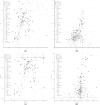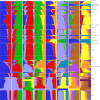Anatolian genetic ancestry in North Lebanese populations
- PMID: 38969748
- PMCID: PMC11226446
- DOI: 10.1038/s41598-024-66191-x
Anatolian genetic ancestry in North Lebanese populations
Abstract
Lebanon's rich history as a cultural crossroad spanning millennia has significantly impacted the genetic composition of its population through successive waves of migration and conquests from surrounding regions. Within modern-day Lebanon, the Koura district stands out with its unique cultural foundations, primarily characterized by a notably high concentration of Greek Orthodox Christians compared to the rest of the country. This study investigates whether the prevalence of Greek Orthodoxy in Koura can be attributed to modern Greek heritage or continuous blending resulting from the ongoing influx of refugees and trade interactions with Greece and Anatolia. We analyzed both ancient and modern DNA data from various populations in the region which could have played a role in shaping the current population of Koura using our own and published data. Our findings indicate that the genetic influence stemming directly from modern Greek immigration into the area appears to be limited. While the historical presence of Greek colonies has left its mark on the region's past, the distinctive character of Koura seems to have been primarily shaped by cultural and political factors, displaying a stronger genetic connection mostly with Anatolia, with affinity to ancient but not modern Greeks.
Keywords: Bioinformatics; F4 statistics; Genomics; Population.
© 2024. The Author(s).
Conflict of interest statement
The authors declare no competing interests.
Figures




References
-
- Chalak L, et al. Extent of the genetic diversity in lebanese olive (Olea europaea l.) trees: A mixture of an ancient germplasm with recently introduced varieties. Genet. Resour. Crop Evol. 2015;62:621–633. doi: 10.1007/s10722-014-0187-1. - DOI
-
- Coyne, J. J. Hellenism and the Aramean people. Stud. Irish Q. Rev.3(10), 64–91 (1914).
-
- Decker M. Frontier settlement and economy in the Byzantine East. Dumbarton Oaks Pap. 2007;61:217–267.
-
- Haider, M. & Iamoni, M. The Rediscovery of Amioun, Ancient Ammiya: The Archaeology of a Regional Capital in the Inner Plain of Koura (Lebanon). The Rediscovery of Amioun, Ancient Ammiya: the Archaeology of a Regional Capital in the Inner Plain of Koura (Lebanon) 53–78 (2021).
MeSH terms
LinkOut - more resources
Full Text Sources
Miscellaneous

